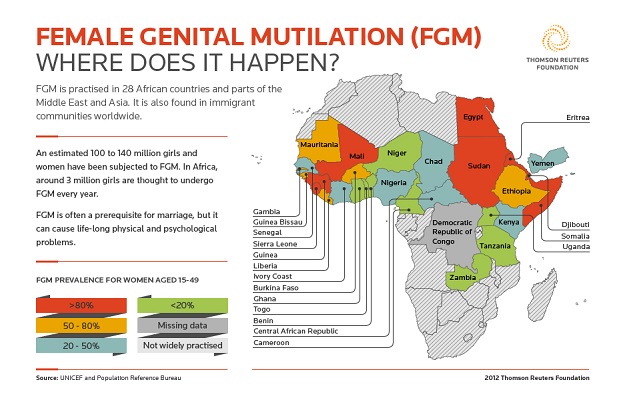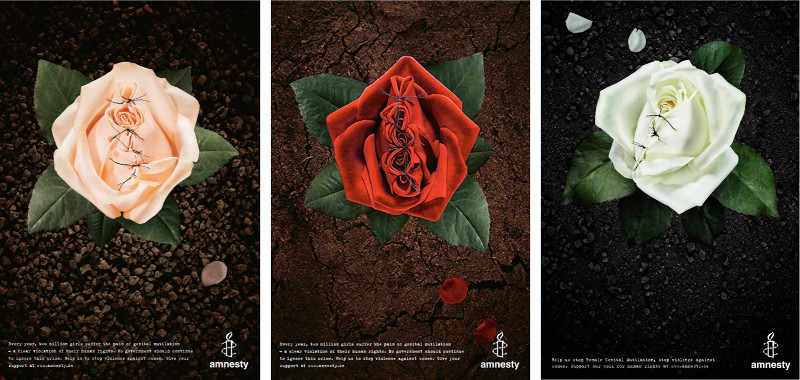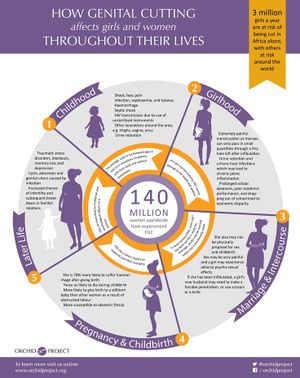Female Genital Mutilation
Introduction
Female Genital Mutilation, also known as Female Genital Cutting, is a traditional practice the occurs around that world. Young girls undergo surgical procedures that involve removal of certain parts of their genitals and alterations including removal of the clitoris or stitching vaginal openings closed. Controversies have developed overtime, leading to the scepticism of this practice. By partaking in this process, many women suffered from infection due to the unsanitary tools used, have lost large amounts of blood, and have even bled to death during the surgical process. These consequences have prompted health concerns among the public as well as the World Health Organization, as they have continuously been analyzing this practice and women and girls’ bodily integrity.[1]
Historical Background
Traditional Practice
Since the female genital cutting process often happens at a young age , it is noted that these girls are not often given the choice of whether or not they wish to take part in this tradition. They are unable to make the decision themselves but are continuously pressured by the beliefs already set by their parents as well as the social norms set by their community. Because the young girls do not want to be ostracized, banished from their village, or looked down upon by their parents and rest of the community, they are left with no choice but to take part in this practice. In places where female genital mutilation is largely practiced, it is believed that being uncircumcised makes the girls unmarriageable. This forces women to conform to the beliefs of society and engage in this painful practice. [2]
Locations
Female genital mutilation occurs in different parts of the world, though it is more prevalent in African, Middle Eastern, and Indonesian countries. [3] Contrary to popular belief, female genital cutting is not only practiced in underdeveloped countries, but is also practiced in countries like the United Kingdom and Australia[4]. In the United Kingdom, some have hired cutters to travel from overseas to mutilate girls in groups in order to save them the cost of travelling to and from other countries where they can have this procedure done.[5] Although people migrate from one place to another, they still hold onto their traditions, which leads to these groups practicing FGM in different parts of the world.

Types of Female Genital Mutilation[6]
Type 1: Clitoridectomy
Clitoridectomy is the process of removing a part or the whole clitoris. In some cases, part of the prepuce is also removed.
Type 2: Excision
Excision is the partial or entire removal of the clitoris and part of the labia. Both the clitoris and the labia are particularly sensitive, making the process of removal extremely painful for the woman and often leads to a high risk of infection.
Type 3: Infibulation
Infibulation is narrowing the opening of a woman’s genitals through cutting and sewing the outer part of the labia. This processes makes it difficult for women to excrete fluids from menstruation and urination, leading to infection and extreme pain.
Type 4: Other
Type four includes any other processes that include harming the female genitalia for non-medical purposes. Some examples of this are piercing, pricking, or scraping.

Problems with Female Genital Mutlation
Infection
There are specific aspects of this practice, especially in sub-Saharan Africa, that have captured the imagination of health and human rights activists, medical anthropologists and ordinary citizens. Though FGM practices have developed over the years, the risk of diseases and infections are high due to the unsanitary conditions or procedures. Diseases are easily spread through the materials used to conduct the FGM procedure can result in many lives being at risk. Although FGM is used to save a women’s virginity for her husband on their wedding night, their first time experiencing intercourse is often painful or impossible because of the small opening created through circumcision. Before engaging in intercourse with her husband for the first time, the tissue that was once sewn together is cut by her husband or a midwife, or torn in the attempt to participate in intercourse. Regardless of the method of removal, infections and excess bleeding can occur, which can lead to further health complications [7].

Child Birth
Having an infibulated vagina can also cause problems when trying to give birth. The birthing process becomes dangerous for both the baby and the mother and can result in either one or both people passing away in the process. The research of the World Health Organization, regarding female genital mutilation, states that women who have gone through this process have an increased risk of having a Caesarean section birth, difficulties when they are in labour, and prolonged labour. Women who have undergone the type 3 process have a greater risk of postpartum haemorrhage, which requires a prolonged hospital stay in order to treat the haemorrhage. FGM can also result in a higher chance of a still birth and neonatal death when the baby is being delivered.[8]
Intimacy During Intercourse
Based on the statistics, many lives could have been saved by not participating in this surgical process. Not only are girls and women impacted during their birthing process but also experience problems when trying to conceive children through intercourse. Because of the damage done to their genitals, it makes intercourse more painful than pleasurable, causing them to lose sexual interest [9]. Even if they have an emotional connection with their spouse, it makes it hard for them to be sexually satisfied due to the tissue damage. Thus, making it harder for them to conceive a child if they wish to do so.
Emotional Scars
Not only do women suffer from physical scars but are also greatly scarred emotionally. By partaking in female genital mutilation, women are more likely to suffer from anxiety, post-traumatic stress disorder, and depression. Although this practice is believed to make a woman more desirable in certain societies, this does not prevent them from being affected mentally.[10]
In a clip from the movie Desert Flower the protagonist, Waris Dirie, speaks out about her experience with female genital cutting to an auditorium full of people. Dirie talks about the social standards that people of her community have for the women who live there and how the trauma from her experience has impacted her life.[11]
Banning Female Genital Mutilation
As of December 2015, 41 countries ban female genital mutilation, including 24 countries in Africa, where FGM is more common, and 18 other countries in other parts of the world. Penalties range from six months in prison to a life in prison, depending on the country.[12]
Female genital mutilation is banned by law in the following countries in Africa:[13]
- Benin (2003)
- Burkina Faso (1996)
- Central African Republic (1996, 2006)
- Chad (2003)
- Cote d'Ivoire (1998)
- Djibouti (1994, 2009)
- Egypt (2008)
- Eritrea (2007)
- Ethiopia (2004)
- The Gambia (2015)
- Ghana (1994, 2007)
- Guinea (1965, 2000)
- Guinea Bissau (2011)
- Kenya (2001, 2011)
- Mauritania (2005)
- Niger (2003)
- Nigeria (2015)
- Senegal (1999)
- South Africa (2000)
- Sudan (state of South Kordofan 2008, state of Gedaref 2009)
- Tanzania (1998)
- Togo (1998)
- Uganda (2010)
- Zambia (2005, 2011)
Female genital mutilation is banned by law in the following countries in outside of Africa:[14]
- Australia (6 out of 8 states between 1994-2006)
- Austria (2002)
- Belgium (2000)
- Canada (1997)
- Colombia (Resolution No. 001 of 2009 by indigenous authorities)
- Cyprus (2003)
- Denmark (2003)
- France (Penal Code, 1979)
- Italy (2005)
- Luxembourg (on mutilations only, not specifically on 'genital' mutilation, 2008)
- New Zealand (1995)
- Norway (1995)
- Portugal (2007)
- Spain (2003)
- Sweden (1982, 1998)
- Switzerland (2005, new stricter penal norm in 2012)
- United Kingdom (1985)
- United States (1996)
Issues with Banning Female Genital Mutilation
Though banning FGM is the most logical way to prevent the consequences that come with the practice, women being uncircumcised is still viewed as impure to some cultures. By banning FGM, it is taking away a historically practiced tradition and keeping these people from practicing something that they have believed in for thousands of years. For instance, some groups believe that this practice is one the first steps to becoming a woman [15] and believe that it is what is best for their daughters, regardless of the physical and emotional harm that it will cause in the future. Others believe that this is the only way to keep their daughters pure until they present themselves to their husbands on their wedding night [16]. Regardless of the traditional beliefs of those who practice female genital cutting, it is important to be wary of the all the long term risks that these women will face.
Notes
- ↑ Gruenbaum, E. (2006). Anthropology and Public Health
- ↑ Gruenbaum, E. (2006). Sexuality Issues in the Movement to Abolish Female Genital Cutting in Sudan
- ↑ http://www.dofeve.org/about-fgm.html
- ↑ http://www.netfa.com.au/where-does-female-genital-mutilation-cutting-fgm-c-happen.php
- ↑ https://www.theguardian.com/society/2014/feb/06/female-genital-mutilation-foreign-crime-common-uk
- ↑ http://www.who.int/mediacentre/factsheets/fs241/en/)
- ↑ Gruenbaum, E. (2006). Anthropology and Public Health
- ↑ http://www.who.int/reproductivehealth/topics/fgm/health_consequences_fgm/en/
- ↑ Gruenbaum, E. (2006). Anthropology and Public Health
- ↑ http://www.who.int/reproductivehealth/topics/fgm/health_consequences_fgm/en/
- ↑ http://www.desertflower-movie.com/
- ↑ http://www.unfpa.org/resources/female-genital-mutilation-fgm-frequently-asked-questions#banned_by_law
- ↑ http://www.unfpa.org/resources/female-genital-mutilation-fgm-frequently-asked-questions#banned_by_law
- ↑ http://www.unfpa.org/resources/female-genital-mutilation-fgm-frequently-asked-questions#banned_by_law
- ↑ http://www.dofeve.org/about-fgm.html
- ↑ Gruenbaum, E. (2006). Sexuality Issues in the Movement to Abolish Female Genital Cutting in Sudan
References
Daughters of Eve. (2016). About FGM. [online] Available at: http://www.dofeve.org/about-fgm.html [Accessed 3 Aug. 2016].
Gruenbaum, E. (2006). Anthropology and Public Health. Oxford University Press, Second Edition 1.
Gruenbaum, E. (2006). Sexuality Issues in the Movement to Abolish Female Genital Cutting in Sudan. Medical Anthropology Quarterly, 20(1), pp.121-138.
Netfa.com.au. (2016). Where does Female Genital Mutilation/Cutting (FGM/C) happen? | NETFA. [online] Available at: http://www.netfa.com.au/where-does-female-genital-mutilation-cutting-fgm-c-happen.php [Accessed 3 Aug. 2016].
Unfpa.org. (2016). Female genital mutilation (FGM) frequently asked questions | UNFPA - United Nations Population Fund. [online] Available at: http://www.unfpa.org/resources/female-genital-mutilation-fgm-frequently-asked-questions#banned_by_lawhttp://www.who.int/mediacentre/factsheets/fs241/en/ [Accessed 3 Aug. 2016].
Verleih, M. (2016). DESERT FLOWER. [online] Desertflower-movie.com. Available at: http://www.desertflower-movie.com/ [Accessed 3 Aug. 2016].
World Health Organization. (2016). Female genital mutilation. [online] Available at: http://www.who.int/mediacentre/factsheets/fs241/en/ [Accessed 3 Aug. 2016].
World Health Organization. (2016). Health risks of female genital mutilation (FGM). [online] Available at: http://www.who.int/reproductivehealth/topics/fgm/health_consequences_fgm/en/ [Accessed 3 Aug. 2016].
Topping, A. and Carson, M. (2014). FGM is banned but very much alive in the UK. [online] the Guardian. Available at: https://www.theguardian.com/society/2014/feb/06/female-genital-mutilation-foreign-crime-common-uk [Accessed 3 Aug. 2016].